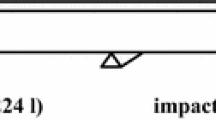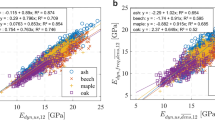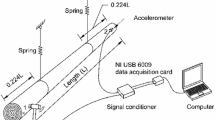Abstract
Non-destructive testing was used to predict the static modulus of elasticity (MOES) of Scots pine (Pinus sylvestris) timber from the northeast of Spain. Three vibration tests were performed, longitudinal, flatwise and edgewise, to obtain the dynamic modulus of elasticity (MOEdyn) based on the fundamental resonant frequencies. The MOEdyn was additionally obtained from ultrasound tests. Measurements of different features were performed of the various samples, which were also subjected to a bending test to find the MOES. Different types of models, simple linear regression (SLR), multiple linear regression (MLR) and artificial neural network (ANN), were generated to predict the MOES based on the study variables. The predictive capacity of the different models was analysed by comparing the root mean square error (RMSE) obtained using the tenfold cross-validation method. The vibration techniques showed a better MOES prediction than the ultrasound techniques. The MOEdyn obtained from the fundamental resonant frequency of the edgewise flexural vibration (MOEEV) was the variable that best predicted the MOES. The error of the SLR with MOEEV was not significantly improved by any other model, whether univariate or multivariate. The ANN-based models did not significantly improve the error of the MLR-based models.



Similar content being viewed by others
References
Alexander DLJ, Tropsha A, Winkler DA (2015) Beware of R2: simple, unambiguous assessment of the prediction accuracy of QSAR and QSPR models. J Chem Inf Model 55:1316–1322
Arriaga F, Iniguez-Gonzalez G, Esteban M, Divos F (2012) Vibration method for grading of large cross-section coniferous timber species. Holzforschung 66:381–387
Arriaga F, Monton J, Segues E, Iniguez-Gonzalez G (2014) Determination of the mechanical properties of radiata pine timber by means of longitudinal and transverse vibration methods. Holzforschung 68:299–305
ASTM Standard (2015) E1876–15 standard test method for dynamic young’s modulus, shear modulus, and Poisson’s ratio by impulse excitation of vibration. ASTM, West Conshohocken
Audacity Team (2015) Audacity®. Version 2.1.12. Audio editor and recorder. http://audacityteam.org/
Baar J, Tippner J, Rademacher P (2015) Prediction of mechanical properties—modulus of rupture and modulus of elasticity—of five tropical species by nondestructive methods. Maderas-Cienc Tecnol 17:239–252
Barrett JD, Hong JP (2010) Moisture content adjustments for dynamic modulus of elasticity of wood members. Wood Sci Technol 44:485–495
Brancheriau L, Bailleres H (2002) Natural vibration analysis of clear wooden beams: a theoretical review. Wood Sci Technol 36:347–365
Chauhan S, Sethy A (2016) Differences in dynamic modulus of elasticity determined by three vibration methods and their relationship with static modulus of elasticity. Maderas-Cienc Tecnol 18:373–382
Cheng F, Hu Y (2011) Reliability analysis of timber structure design of poplar lumber with nondestructive testing methods. BioResources 6:3188–3198
Cho CL (2007) Comparison of three methods for determining Young’s modulus of wood. Taiwan J Forest Sci 22:297–306
Esteban LG, Fernández FG, De Palacios P (2009) MOE prediction in Abies pinsapo Boiss. timber: application of an artificial neural network using non-destructive testing. Comput Struct 87:1360–1365
European Standard (2002a) EN 13183-1. Moisture content of a piece of sawn timber. Part 1: determination by oven dry method. European Comittee for Standardization (CEN), Brussels
European Standard (2002b) EN 13183-2 Moisture content of a piece of sawn timber—part 2: estimation by electrical resistance method. European Comittee for Standardization (CEN), Brussels
European Standard (2012) EN 408:2010+A1:2012. Timber structures. Structural timber and glued laminated timber. Determination of some physical and mechanical properties. European Comittee for Standardization (CEN), Belgium
European Standard (2016) EN 338:2016. Structural timber Strength classes. European Comittee for Standardization (CEN), Brussels
European Standard (2018) EN 1309-3:2018. Round and sawn timber—methods of measurements—part 3: features and biological degradations. European Comittee for Standardization (CEN), Brussels
Faydi Y, Brancheriau L, Pot G, Collet R (2017) Prediction of oak wood mechanical properties based on the statistical exploitation of vibrational response. BioResources 12:5913–5927
García-Iruela A, Fernández FG, Esteban LG, De Palacios P, Simón C, Arriaga F (2016) Comparison of modelling using regression techniques and an artificial neural network for obtaining the static modulus of elasticity of Pinus radiata D. Don. timber by ultrasound. Compos Part B-Eng 96:112–118
Guntekin E, Emiroglu Z, Yilmaz T (2013) Prediction of Bending properties for Turkish Red Pine (Pinus brutia Ten.) Lumber using stress wave method. BioResources 8:231–237
Halabe UB, Bidigalu GM, GangaRao HVS, Ross RJ (1997) Nondestructive evaluation of green wood using stress wave and transverse vibration techniques. Mater Eval 55:1013–1018
Hashim UR, Hashim SZM, Muda AK (2016) Performance evaluation of multivariate texture descriptor for classification of timber defect. Optik 127:6071–6080
Hassan KTS, Horacek P, Tippnera J (2013) Evaluation of stiffness and strength of scots pine wood using resonance frequency and ultrasonic techniques. BioResources 8:1634–1645
Hodousek M, Dias M, Martins C, Marques A, Böhm M (2016) Comparison of non-destructive methods based on natural frequency for determining the modulus of elasticity of Cupressus lusitanica and Populus x canadiensis. BioResources 12:270–282
How SS, Williamson CJ, Carradine D, Tan YE, Cambridge J, Pang S (2014) Predicting the young’s modulus of defect free radiata pine shooks in finger-jointing using resonance frequency. Maderas-Cienc Tecnol 16:435–444
Ilic J (2001) Relationship among the dynamic and static elastic properties of air-dry Eucalyptus delegatensis R. Baker Holz Roh Werkst 59:169–175
Íñiguez González G, Arriaga Martitegui F, Esteban Herrero M, Argüelles Alvárez R (2007) Los métodos de vibración como herramienta no destructiva para la estimación de las propiedades resistentes de la madera aserrada estructural [Vibration methods as non-destructive tool for structural properties assessment of sawn timber]. Inf Constr 59:97–105
Larsson D, Ohlsson S, Perstorper M, Brundin J (1998) Mechanical properties of sawn timber from Norway spruce. Holz Roh Werkst 56:331–338
Lever J, Krzywinski M, Altman N (2016) Model selection and overfitting. Nat Methods 13:703–704
Liu Y, Gong M, Li L, Chui YH (2014) Width effect on the modulus of elasticity of hardwood lumber measured by non-destructive evaluation techniques. Constr Build Mater 50:276–280
Mania P, Siuda F, Roszyk E (2020) Effect of slope grain on mechanical properties of different wood species. Materials 13:1503
Nocetti M, Brunetti M, Bacher M (2016) Efficiency of the machine grading of chestnut structural timber: prediction of strength classes by dry and wet measurements. Mater Struct 49:4439–4450
Pardos JA, Werner L, Günter W (1990) Morphological and chemical aspects of Pinus sylvestris L. from Spain. Holzforschung 44:143–146
Pommier R, Breysse D, Dumail JF (2013) Non-destructive grading of green Maritime pine using the vibration method. Eur J Wood Prod 71:663–673
R Core Team (2019) R: A language and environment for statistical computing. Version 3.6.1. R Foundation for Statistical Computing, Vienna. http://www.R-project.org/
Ranta-Maunus A, Denzler JK, Stapel P (2011) Strength of European timber. Part 2. Properties of spruce and pine tested in Gradewood project. VTT Technical Research Centre of Finland. VTT Working Papers, No. 179 http://www.vtt.fi/inf/pdf/workingpapers/2011/W179.pdf
Refaeilzadeh P, Tang L, Liu H (2009) Cross-validation. In: Liu L, Özsu MT (eds) Encyclopedia of database systems. Springer, US, Boston, pp 532–538
Sales A, Candian M, De Salles CV (2011) Evaluation of the mechanical properties of Brazilian lumber (Goupia glabra) by nondestructive techniques. Constr Build Mater 25:1450–1454
Sandoz JL (1989) Grading of construction timeber by ultrasound. Wood Sci Technol 23:95–108
Simic K, Gendvilas V, O’Reilly C, Harte AM (2019) Predicting structural timber grade-determining properties using acoustic and density measurements on young Sitka spruce trees and logs. Holzforschung 73:139–149
Spycher M, Schwarze FWMR, Steiger R (2008) Assessment of resonance wood quality by comparing its physical and histological properties. Wood Sci Technol 42:325–342
Tanaka T, Tanaka T, Nagao H, Kato H (1996) A preliminary investigation on evaluation of strength of soft wood timbers by neural network. Proceeding of the 10th International Symposium on Nondestructive Testing of Wood, Lausanne. pp. 323–329
Tetko IV, Livingstone DJ, Luik AI (1995) Neural Network Studies. 1. Comparison of Overfitting and Overtraining. J Chem Inf Comput Sci 35:826–833
Villasante A, Iniguez-Gonzalez G, Puigdomenech L (2019) Comparison of various multivariate models to estimate structural properties by means of non-destructive techniques (NDTs) in Pinus sylvestris L. timber. Holzforschung 73:331–338
Waikato University (2014) WEKA software. Version 3.6.12. Waikato University, Hamilton. https://www.cs.waikato.ac.nz/ml/weka/
Walker J (1993) Primary wood processing: principles and practice. Chapman & Hall, London, pp 348–352
Wang SY, Chen JH, Tsai MJ, Lin CJ, Yang TH (2008) Grading of softwood lumber using non-destructive techniques. J Mater Process Tech 208:149–158
Weaver W, Timoshenko S, Young DH (1990) Vibration problems in engineering. Wiley, New York
Author information
Authors and Affiliations
Corresponding author
Ethics declarations
Conflict of interest
On behalf of all authors, the corresponding author states that there is no conflict of interest.
Additional information
Publisher's Note
Springer Nature remains neutral with regard to jurisdictional claims in published maps and institutional affiliations.
Rights and permissions
About this article
Cite this article
Fernández-Serrano, Á., Villasante, A. Longitudinal, transverse and ultrasound vibration for the prediction of stiffness using models incorporating features in Pinus sylvestris timber. Eur. J. Wood Prod. 79, 1541–1550 (2021). https://doi.org/10.1007/s00107-021-01707-0
Received:
Accepted:
Published:
Issue Date:
DOI: https://doi.org/10.1007/s00107-021-01707-0




